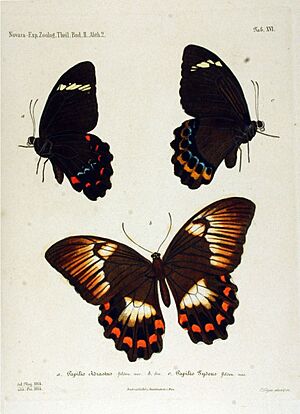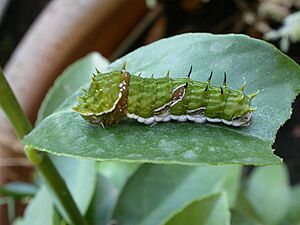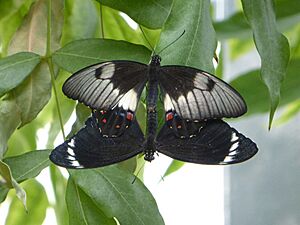Orchard swallowtail butterfly facts for kids
Quick facts for kids Orchard swallowtail butterfly |
|
|---|---|
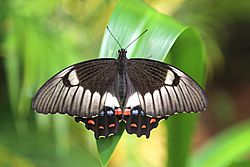 |
|
| Female, Cairns, Queensland | |
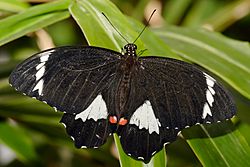 |
|
| Male, Melbourne Zoo | |
| Scientific classification | |
| Kingdom: | |
| Phylum: | |
| Class: | |
| Order: | |
| Family: | |
| Genus: |
Papilio
|
| Species: |
P. aegeus
|
| Binomial name | |
| Papilio aegeus Donovan, 1805
|
|
| Subspecies | |
|
|
 |
|
| Range of orchard swallowtail
P. a. aegeus; P. a. ormenus
P. a. aegeus temporary range |
|
| Synonyms | |
|
|
The orchard swallowtail butterfly, also known as the large citrus butterfly, is a type of butterfly. Its scientific name is Papilio aegeus. You can find this butterfly in eastern Australia and Papua New Guinea.
Sometimes, the young butterflies, called larvae or caterpillars, are seen as a problem. This is because they like to eat the leaves of citrus trees in people's gardens.
Contents
What Does the Orchard Swallowtail Look Like?
Both male and female orchard swallowtails have black front wings. These wings have a white stripe. Females usually have more white on their front wings than males.
Their back wings are also black. They have a white area in the middle. The female's back wings have special markings. These are chains of red, orange, and blue crescent shapes near the edge. The patterns on the underside of their wings are similar to the top. Their bodies are black.
These butterflies are quite large. Females can have a wingspan of about 140 millimeters (5.5 inches). Males are a bit smaller, with a wingspan of about 120 millimeters (4.7 inches). This makes them one of the biggest butterflies you might see in their home areas.
Even though they are called "swallowtail" butterflies, this species does not have the long, tail-like parts on their back wings that many other swallowtails have.
Where Do Orchard Swallowtail Butterflies Live?
You can find Papilio aegeus in almost every state in Australia, except for Tasmania. There are even groups of them living in the Albany area of Western Australia.
They are very common in Queensland. In places like Brisbane, where many citrus trees grow, they are the largest butterfly often seen. During the summer, they can even spread temporarily into Victoria.
A special type, or subspecies, called P. a. ormenus lives in Papua New Guinea and on Thursday Island. One way to tell the difference between the males of P. a. aegeus and P. a. ormenus is that P. a. aegeus males have a red spot on their back wings, which P. a. ormenus males do not. Other subspecies live on islands in the Banda Sea and Bismarck Sea.
Different Types of Orchard Swallowtails
Subspecies of Orchard Swallowtail
There are several subspecies of the orchard swallowtail butterfly. Here are a few:
- P. a. aegeus — Found from Cape York to East Victoria and South Australia.
- P. a. ormenus — Found in places like New Guinea and the Torres Straits Islands.
Forms of Female Butterflies
Female orchard swallowtails, both P. a. aegeus and P. a. ormenus, can look different. They have three main forms:
- Regular form: This is the most common look.
- Pale form: These females have yellow spots on their back wings instead of the usual red. Their front wings are almost completely white.
- Dark form: The front wings of these females are almost all black. Their back wings have a smaller white patch.
Life Cycle of the Orchard Swallowtail
Egg Stage
Female butterflies lay their eggs one by one. The eggs are creamy white, smooth, and round, about 0.5 millimeters wide. They are usually placed on the top side of leaves or new shoots of host plants. These plants are mostly from the Rutaceae family, which includes citrus trees. The eggs will hatch into caterpillars in about one week.
Larva (Caterpillar) Stage
When they first hatch, the young caterpillars are brown. They have three white patches on their body. They also have black and white bumps. These caterpillars only eat citrus leaves. During the day, they eat. At night, they rest on the top of leaves, looking a bit like bird droppings.
As they grow, the caterpillars turn green. They get white, yellow, or brown markings that go across their bodies. After about four weeks, a caterpillar can be 60 millimeters (2.4 inches) long. At this point, it is ready to change into a pupa.
If a caterpillar feels threatened, it can stick out a bright red, Y-shaped organ called an osmeterium from behind its head. This releases a citrus smell that helps scare away predators.
Pupa Stage
The pupa, also called a chrysalis, can be grey, green, or brown. Its color helps it blend in with the stem it is attached to. The chrysalis hangs from a stem of the host plant. A thin silk thread holds the head end of the chrysalis up. After about one to six months, depending on the season, an adult butterfly will come out of the chrysalis.
What Do Caterpillars Eat?

Orchard swallowtail caterpillars eat leaves from many different plants, especially citrus.
Native Plants
In Australia, the caterpillars naturally eat plants like Boronia, Citrus, Flindersia, and Zanthoxylum.
Introduced Plants
They also eat plants that have been brought to Australia, such as other types of Citrus, Choisya, and Murraya.
Images for kids
See also
 In Spanish: Papilio de los vergeles para niños
In Spanish: Papilio de los vergeles para niños


